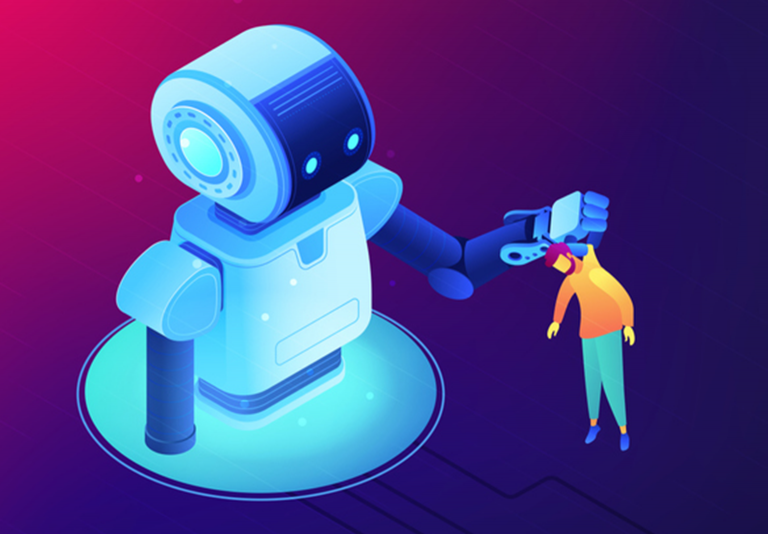- Corporate Culture
- Janina Bernardo
- April 24, 2023
Harnessing Human Skills Amidst the AI Revolution

Artificial intelligence (AI) has been gaining much attention in the media in recent months with the public release of ChatGPT. AI is revolutionizing the workplace by automating repetitive tasks, enhancing decision-making and data analysis, and boosting productivity.
While AI can provide organizations with a competitive edge, it will significantly impact the role of people at work. It will alter how employees do their tasks, the skills they require, and the overall structure of the workplace. As technology advances, it is more important than ever for businesses to invest in employee development and reskill their team so they can adapt and maximize the power of artificial intelligence.
Forward-thinking business leaders who can seamlessly employ AI technology while harnessing human skills can expect significant productivity and performance benefits.
Shifting the Focus on Human-centric Soft Skills
Critical thinking and Problem-solving
Employees must expand their ability to navigate complex situations by identifying underlying issues and evaluating potential solutions. This requires challenging assumptions, contemplating alternative viewpoints, employing logical reasoning, and mindset change. In the finance industry, for example, managers must examine the possible effects of new legislation on how they work as well as how the new law will affect their clients. This requires analytical, creative (imagining different scenarios), and problem-solving skills.
Adaptability and Resilience
The rapid rate of technological change requires employees to be flexible and willing to acquire new skills. An adaptable person can keep up with shifting objectives, projects, clients, and technology. They have a growth mindset, believing they can constantly learn and keep getting better. Employees with a growth mindset are more willing to try new things and take on new responsibilities. They frequently see the big picture and are less likely to let failures hold them back. Failure is simply an opportunity to gain new insights and improve.
Collaboration and Teamwork
Collaboration means more than working together to finish a job. To collaborate effectively, individuals must form genuine connections with coworkers, learn how to manage disputes and create an inclusive, respectful working environment. Employees get more anxious about their work when they do not feel part of a team. It can lead to lower general well-being and increased absenteeism. In a collaborative workplace, one can see how their efforts contribute to the business’s overall success, which leads to better engagement and higher job satisfaction.
Communication and the Power of Storytelling
Storytelling is an essential part of all societies and cultures. In business, storytelling is more than a communication tool to get things done – it’s a way for leaders to communicate their vision and inspire others. Whether it’s about instilling values, creating high-performance teams, or fostering mindset change, by engaging emotions, storytelling can be an impetus to spark change.
How Experiential Training Bridges the Gap
While traditional learning and development training will always have its place, you can’t learn soft skills through simple knowledge transfer. Individuals do not learn to ride a bike or speak a new language by observing others. Communication, teamwork, accountability, and problem-solving are all soft skills that involve knowledge, but they are actually more about action.
Experiential learning employs simulations and role-playing to provide employees with a hands-on approach to help them apply their skills and knowledge in the workplace. It is an engaging and fun way of learning that encourages employees to experiment with new methods and practice new skills.
A hands-on approach stimulates active learning and allows individuals to understand concepts better and retain knowledge. It enables employees to modify behavior or master a skill by putting what they’ve learned in training into practice in a safe environment where they can get quick feedback and coaching in real time.
Measuring the Impact of Experiential Learning
As businesses prepare for a more challenging economic climate, it is becoming increasingly difficult to justify training spending. Even if your employees appreciate the training programs and give positive feedback, leaders still struggle to quantify the impact.
Measuring the return on investment from corporate team building is not as difficult as you think.
One strategy is to set a baseline for future comparisons and to outline your objectives in the planning stages. Keeping track of learning and development key indicators before training will allow you to set a benchmark and spot problem areas. Rates of absenteeism, turnover, productivity, and dissatisfaction among customers are some metrics to track.
Training for behavior and mindset change to improve the company culture can be achieved using a survey based on your desired outcomes. Team members must evaluate leaders and managers discreetly to protect their identities. Getting feedback regularly to gauge the long-term results of your learning and development efforts is essential.
Conclusion
AI is a game-changing innovation that companies can’t afford to ignore. Workers may resist AI out of concern that they would lose autonomy over their work and that their established routines might change. Each organization is unique, and implementing change management is essential to future-proof its people. Ensure each member has the leadership development tools they need to succeed in the modern workplace. It not only demonstrates that you prioritize employee experience and development but also helps the company’s bottom line in the long run.
Behavior and mindset change are vital to enable your team to thrive in the age of AI. Our Future-Fit program will empower them for a stronger, more resilient tomorrow. Get in touch with us today to book a consultation for your learning and development needs.
